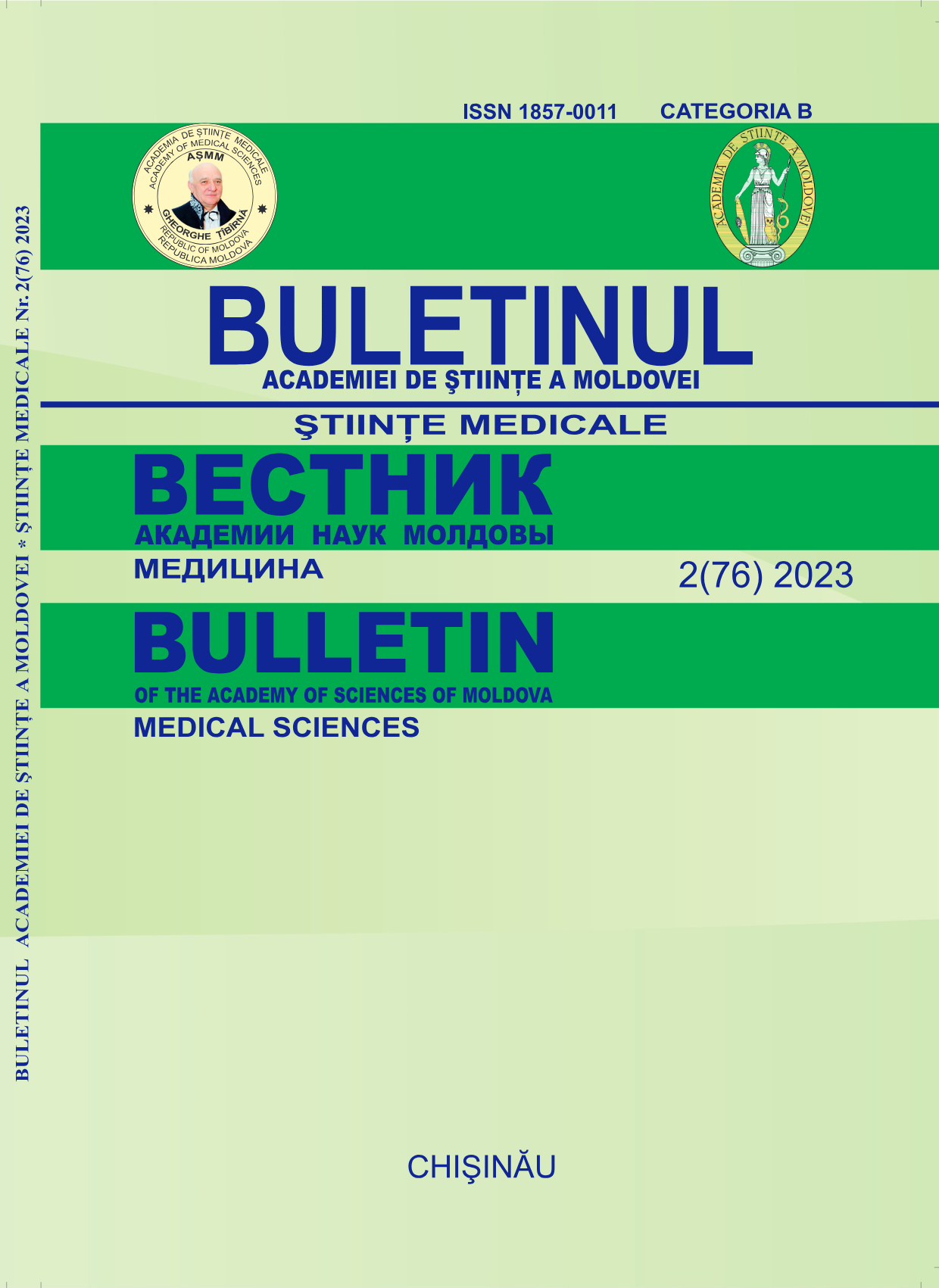Prognostic evaluation of children diagnosed with intracerebral tumors associated by an obstructive hydrocephalus (own results)
DOI:
https://doi.org/10.52692/1857-0011.2023.2-76.03Keywords:
brain tumors, obstructive hydrocephalus, child, evaluation, prognosisAbstract
Tumors of the Central Nervous System (CNS) in children are a special chapter of morbidity, caused by organic and neuropsychological damage. Intracerebral tumors are the most common solid forms at child (2.7 per 100,000 children annually), occupying a large part of the medical care of the child.Having different forms, from the point of view of tissue origin, localization, dissemination, clinical picture, evolution over time and onset (from neonatal to adolescent), significant advances have been made in the diagnosis and treatment of brain tumors. So that at present, the therapeutic approach and their dispensarisation involve a multidisciplinary pediatric neuroscience team consisting of neuropediatry, pediatric, neurosurgeon, oncologist, neuroradiologist, psychologist. The therapeutic decision in brain tumors in the child should be based on the conclusions of a multidisciplinary team. The goal of surgical treatment of brain tumors by a neurosurgeon is to improve the state and avoiding therapeutic errors, preventing long-term neurological sequelae and quality of life of the child.
References
Revista română de pediatrie – vol. LVI, nr. 4, an. 2007
Blaney SM, Larry EK, Hunter J et al. Tumours of the central nervous system. In:PizzoPA,Poplack DG (eds) Principles and practice of Paediatric Oncology (5 th edn) Philadelphia, PA: JB Lippincott, 786-864, 2006.
Cohen ME, Duffner PK (eds). Brain Tumours in Children. Principles of Diagnosis and Treatment. (2nd edn) New York: Raven Press, 1994, 127-46,177-201, 219-39, 445-481
Dufner PK, Korowitz ME, Krischer JP et al. The treatment of malignant brain tumours in infants and very young children: an update of the Pediatric Oncology Group experience. Neurooncology, 1999, 1, 152-161.
Freemen CR, Taylor RE, Kortmann RD, Carrie C. Radiotherapy for medulloblastoma in children: a perspective on current international clinical research efforts. Med Pedatr Oncol, 2002, 39, 99-108
Gotzer MA, Janss AJ, Fung KM et al. TrkC expression predicts good clinical outcome in primitive neuroectodermal brain tumours. J Clin Oncol, 2000, 18, 10271035.
Herms J, Neidt I, Luscher B et al. c-myc expression in meduloblastoma and his prognostic value. Int J Cancer, 2000, 395-402 6. Pomeroy SL, Tamayo P, Gaasenbeck M et al – Prediction of central nervous system embrional tumour outcome based on gene expression. Nature, 2002, 415, 436-442
Heckl, Aschoff A, Kunze S. Radiation-induced cavernous hemangiomas of the brain: a late effect predominantly in children. Cancer, 2002, 94, 3285-3291.
Kleihues P, Cavenee WK (eds) – Pathology and genetics of tumours of the Nervous System. Lyon: IARC (2000).
Ko JK, Cha SH, Choi BK, Lee JI, Yun EY, Choi CH. “Hemorrhage Rates Associated with Two Methods of Ventriculostomy: External Ventricular Drainage vs Ventriculoperitoneal shunt procedure”. Neurol Med Chir(Tokyo).2014 Feb10.
Lo WB, Ramirez R, Rodrigues D, Solanki GA. ”Ventriculoperitoneal shunt disconnection associated with spontaneous knot formation in the peritoneal catheter”. BMJ Case Rep. 2013 May
Kortmann RD, Kuhl J, Timmermann B et al. Current and futures strategies in interdisciplinary treatment of medulloblastoma, supratentorial PNET (primitive neuroectoderman tumours) and intracranial germ cell tumours in childhood. Strahlenther Onkol, 2001, 177, 447-461.
Mandiwanza T, Kaliaperumal C, Caird J. ”Central brain herniation in shunted Dandy Walker cyst”. Childs Nerv Syst. 2013 Jun;
Mattei TA, Salma A, Lin JJ. “Spontaneous bowel perforation from distal catheter leading to meningitis: a rare but frequently overlooked complication of ventriculoperitoneal shunts”. Pediatr Neurol. 2013 Jun
Matsubara T, Ayuzawa S, Aoki T, Ikeda G, Shiigai M, Matsumura A. Neurol Med Chir (Tokyo). “Cerebral venous thrombosis after ventriculoperitoneal shunting: a case report”. Neurol Med Chir (Tokyo). 2013 Nov 20.
Meier U, Stengel D, Müller C, Fritsch MJ, Kehler U, Langer N, Kiefer M, Eymann R, Schuhmann MU, Speil A, Weber F, Remenez V, Rohde V, Ludwig HC, Lemcke Predictors of subsequent overdrainage and clinical outcomes after ventriculoperitoneal shunting for idiopathic normal pressure hydrocephalus. J.Neurosurgery.2013 Dec;73(6):1054-60.
Michaelis J, Kaletsch U, Kaatsch P. Epidemiology of childhood brain tumour. Zentralbl Neurochir, 2000, 61, 80-87.
Mulhern RK, Reddick, WE, Palmer SL et al. Neurocognitive deficits in medulloblastoma survivors and white matter loss. Ann Neurol, 1999, 46, 834-841.
Radcliffe J, Bunin GR, Sutton LN et al – Cognitive deficits in long term survivors of childhood medulloblastoma and other non-cortical tumours: age dependent effects of whole brain irradiation. Int J Dev Neurosci, 1994, 12, 327-334
Siffert J, Allen J.K. Late effects of therapy of thalamic and hypothalamic tumours in childhood: vascular, neurobehavioural and neoplastic. Pediatr Neurosurg, 2000, 33, 105-111.
Гогорян С. Ф. и др. Опухоли головного мозга, сочетающиеся с гидроцефалией. В: Журнал Вопросы нейрохирургии им. Н.Н. Бурденко, 2008, № 4, с. 39-42.
Wikipedia search.
Downloads
Published
License
Copyright (c) 2023 Bulletin of the Academy of Sciences of Moldova. Medical Sciences

This work is licensed under a Creative Commons Attribution 4.0 International License.



